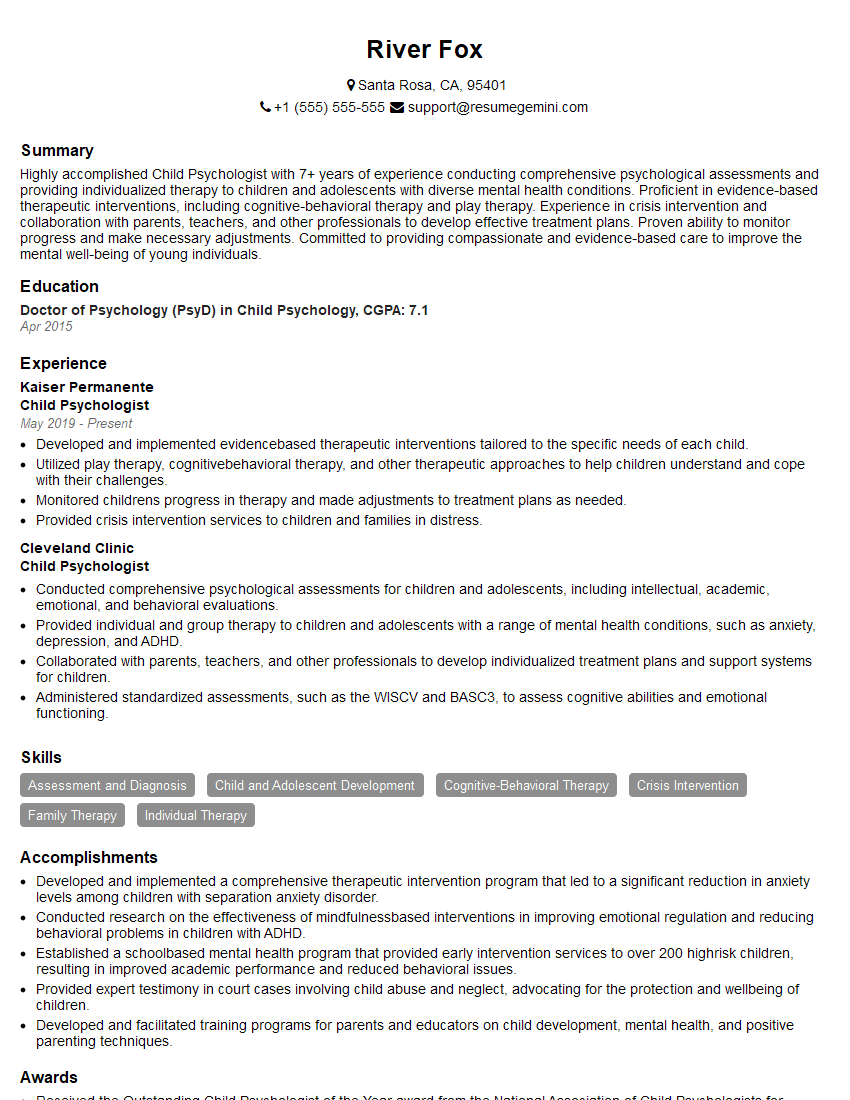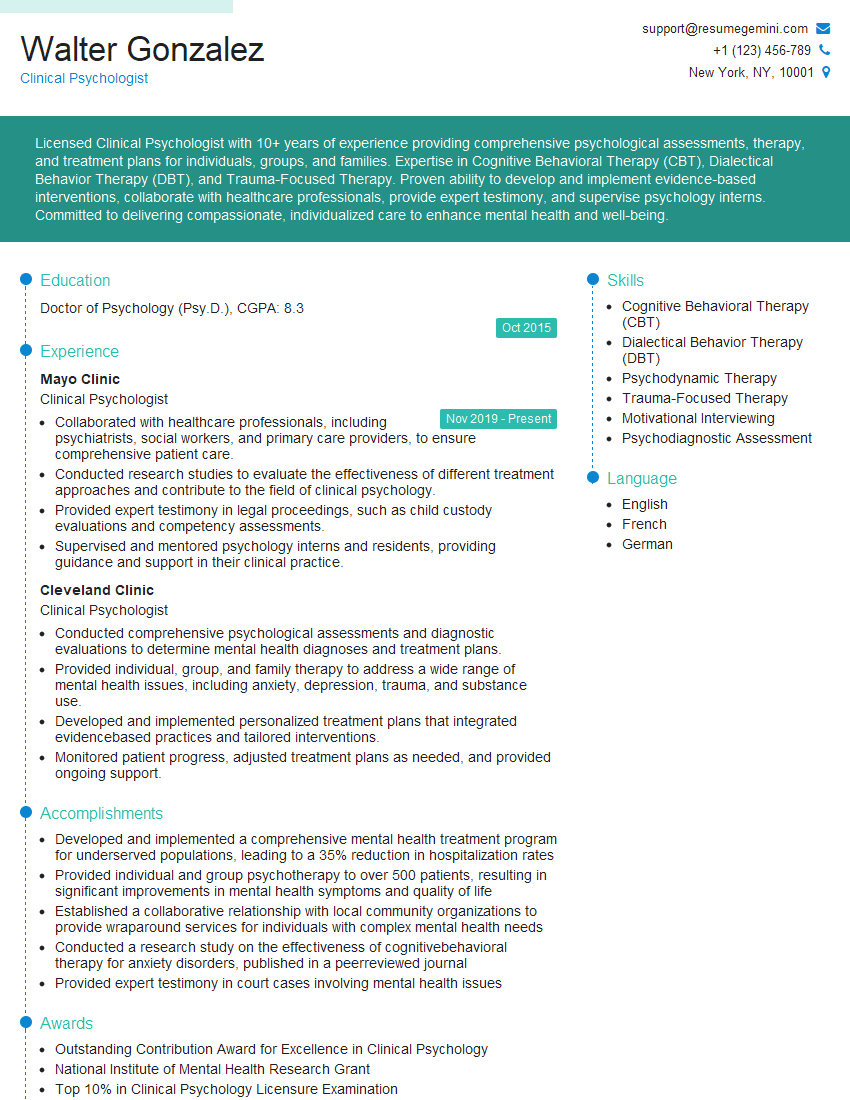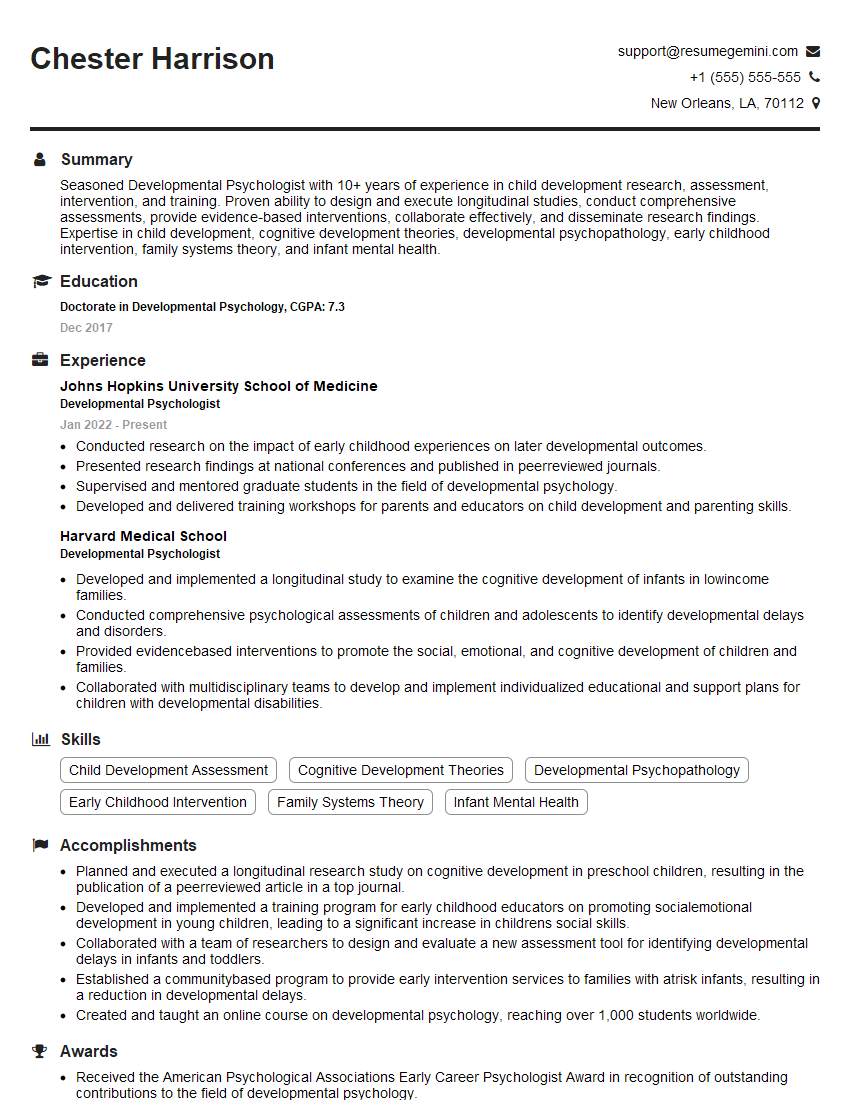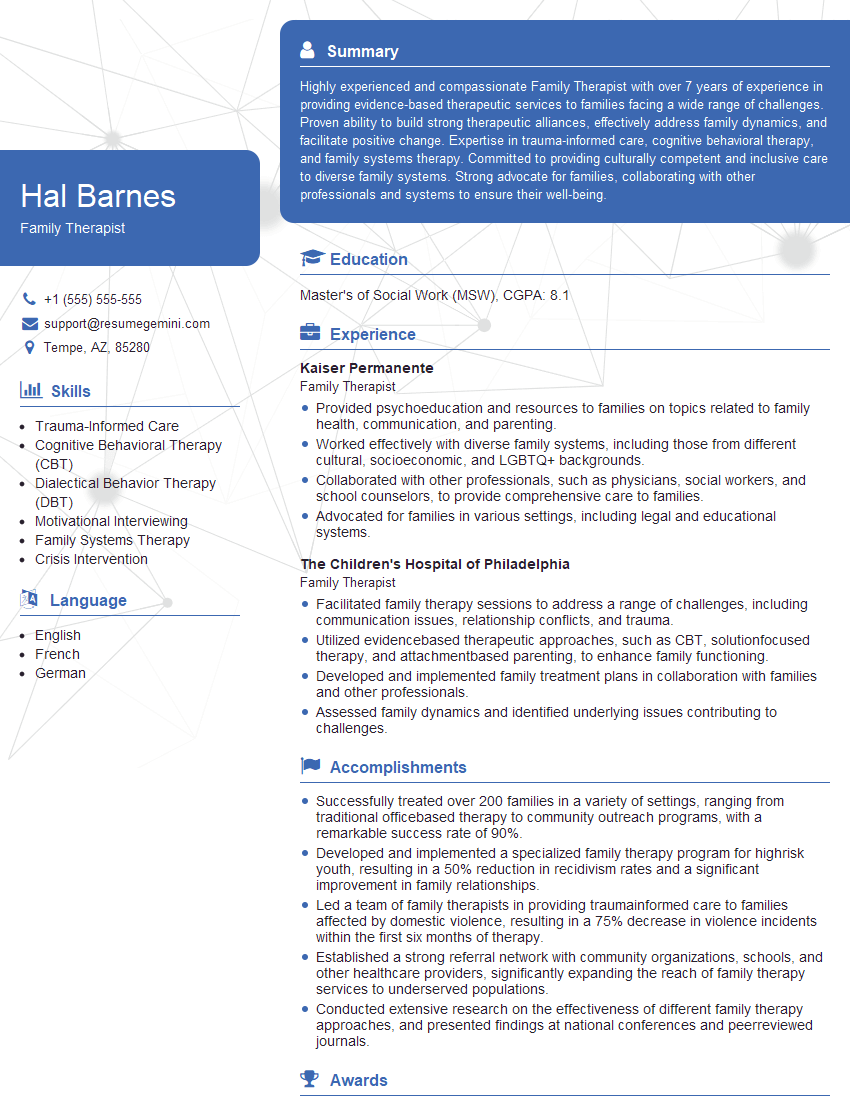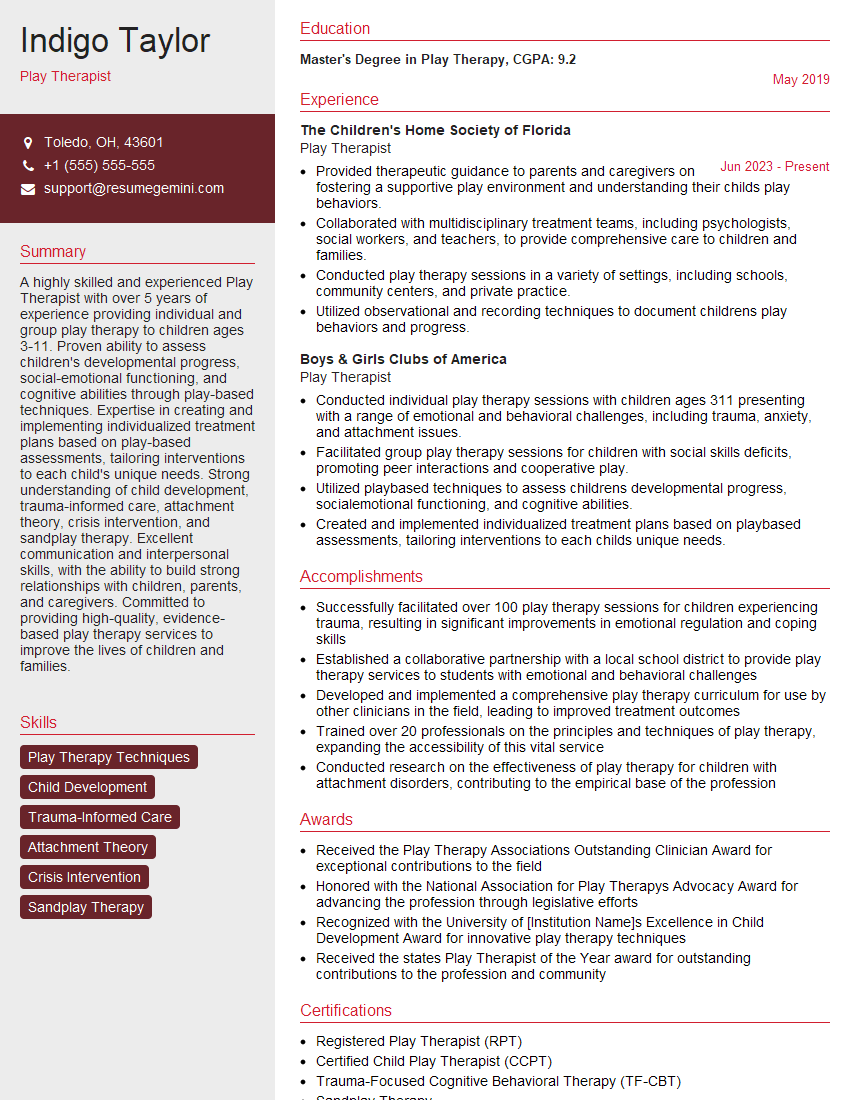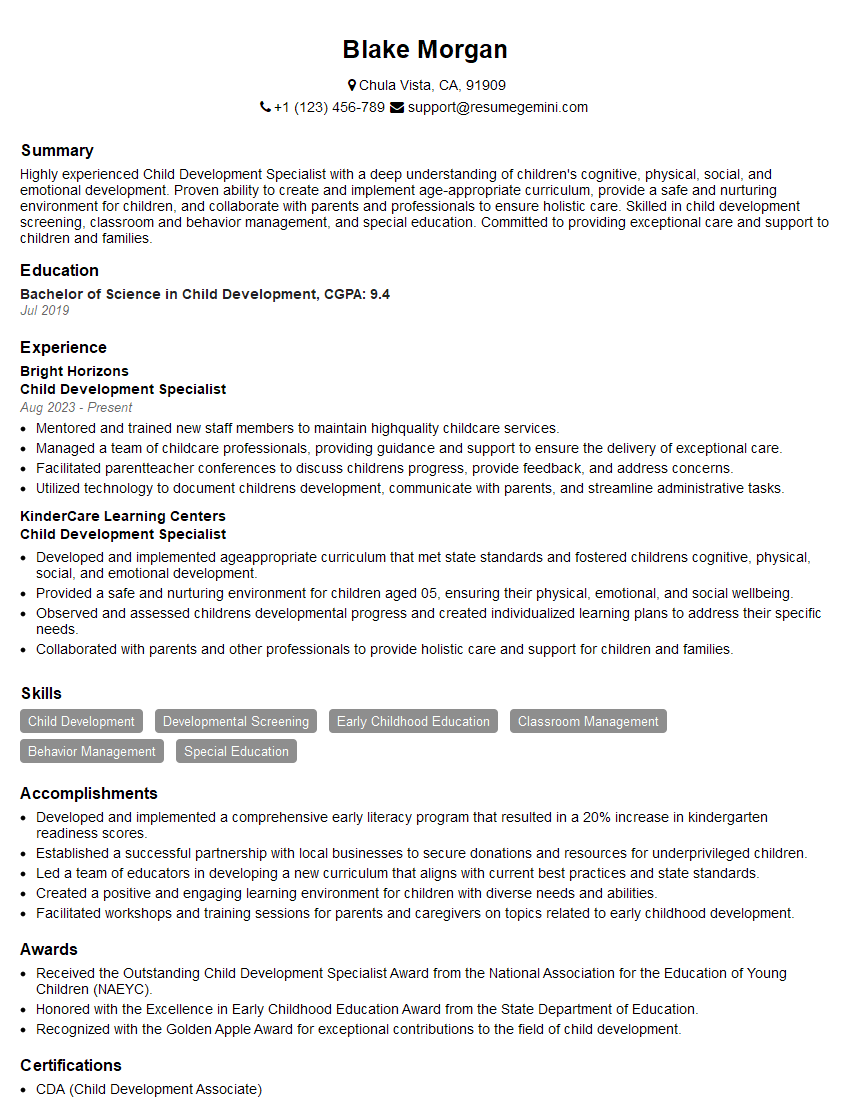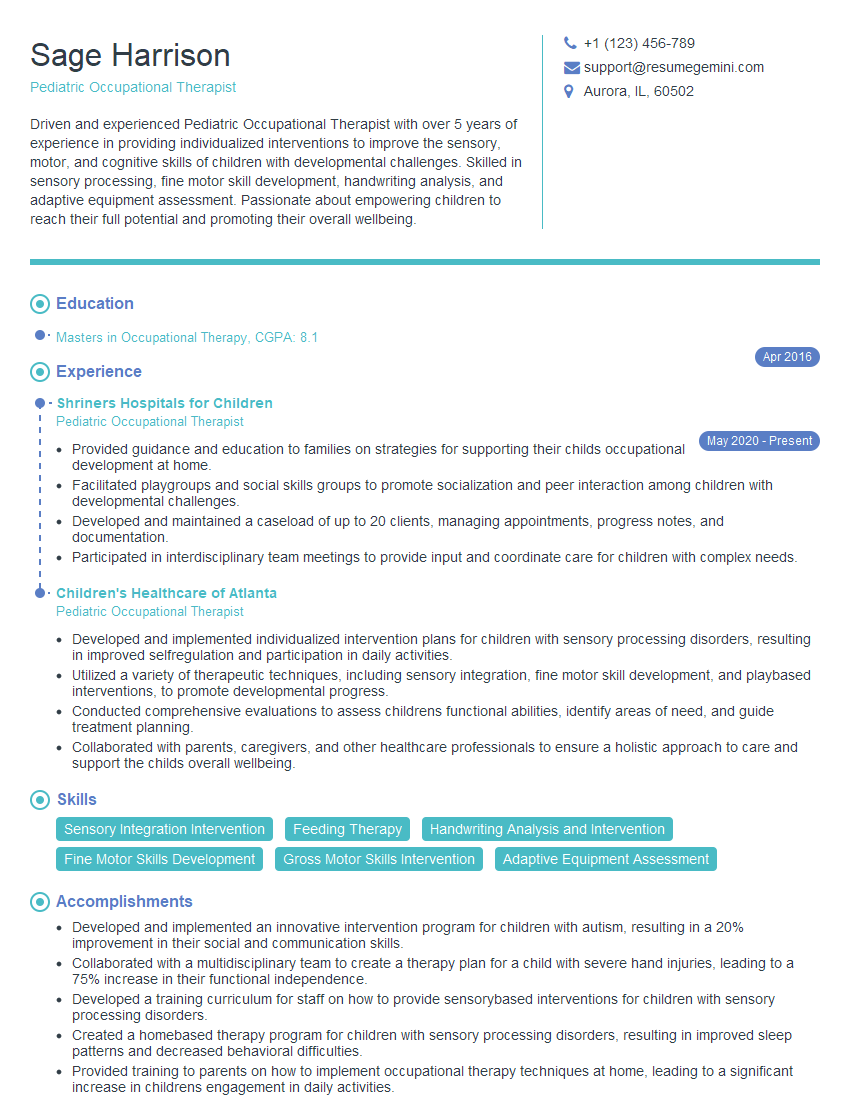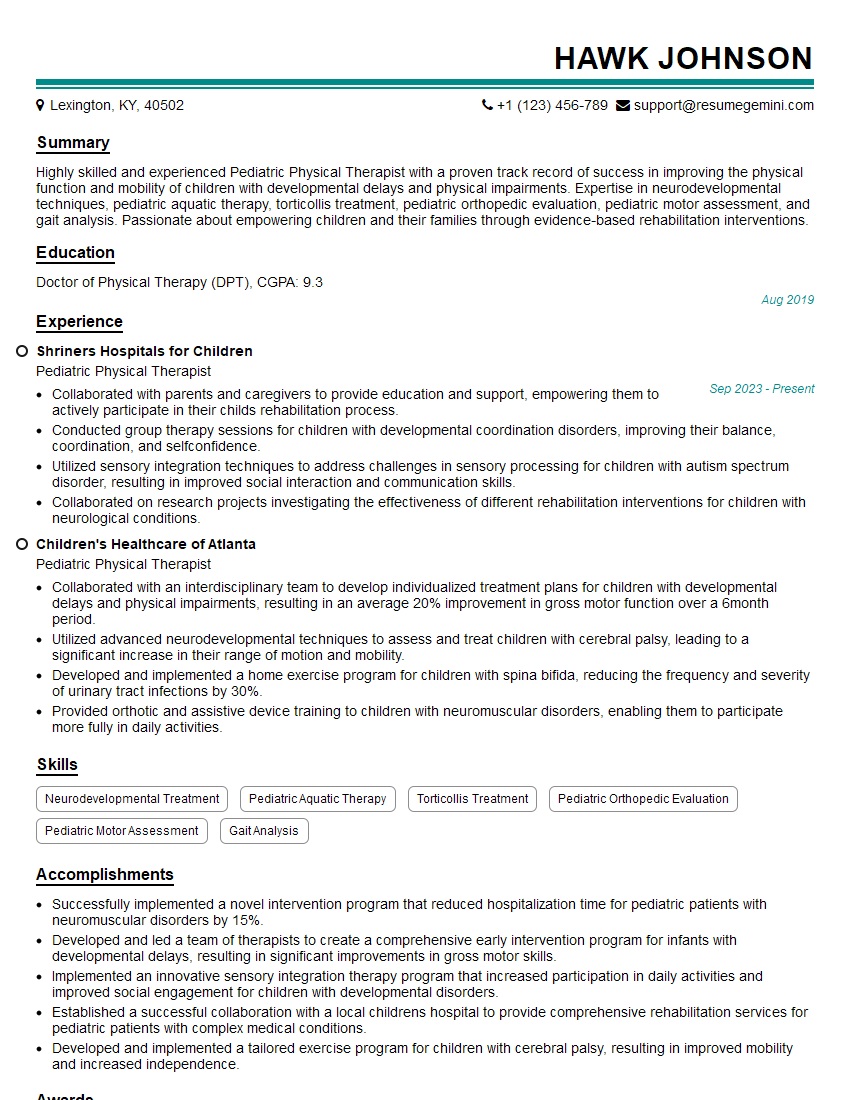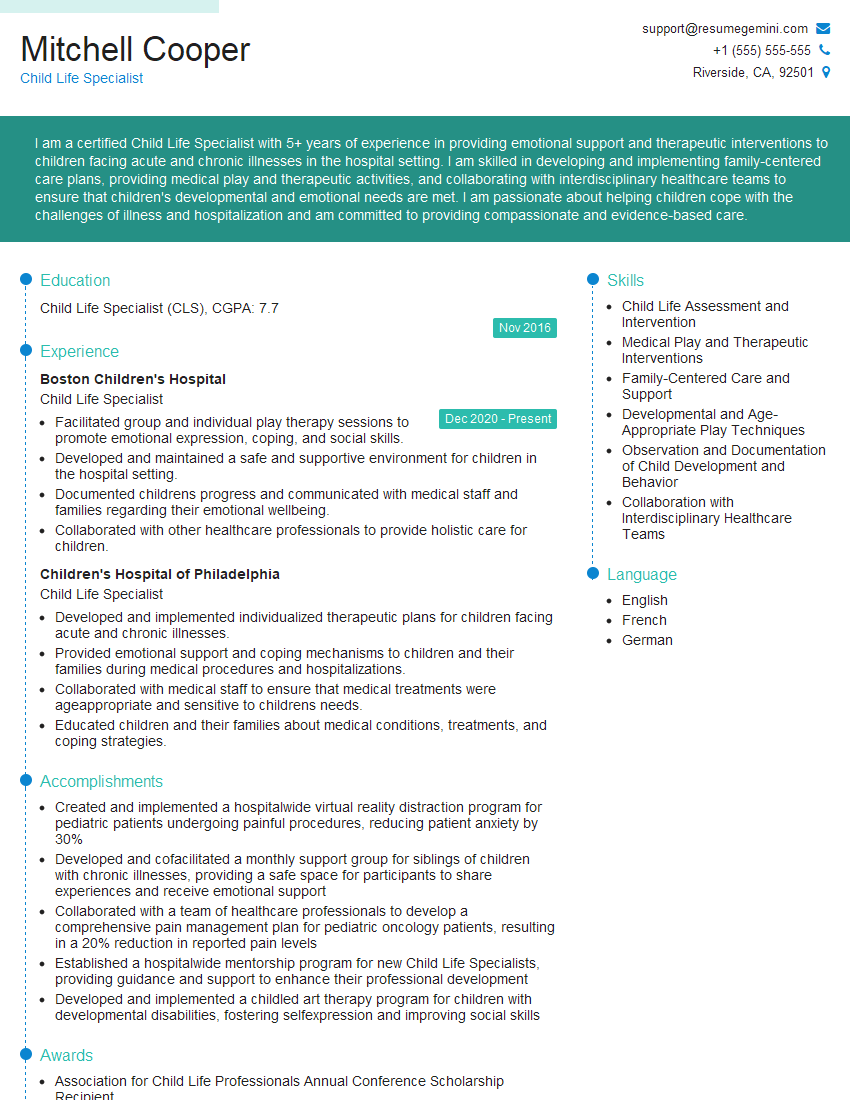Cracking a skill-specific interview, like one for Parent-Child Interaction Observation, requires understanding the nuances of the role. In this blog, we present the questions you’re most likely to encounter, along with insights into how to answer them effectively. Let’s ensure you’re ready to make a strong impression.
Questions Asked in Parent-Child Interaction Observation Interview
Q 1. Describe the key principles of Parent-Child Interaction Observation (PCIO).
Parent-Child Interaction Observation (PCIO) is a powerful method for assessing the quality of parent-child relationships and identifying potential risk factors for child development. Its key principles revolve around observing and systematically coding the interactions between a parent and child in a naturalistic setting, usually their home. This allows researchers and clinicians to understand the dynamics of their relationship. Key principles include:
- Naturalistic Observation: Observations occur in the child’s natural environment, minimizing artificiality and increasing ecological validity.
- Systematic Coding: Utilizing a standardized coding system ensures objectivity and consistency across observations.
- Focus on Bidirectional Interactions: PCIO doesn’t just observe the parent’s behavior; it examines the reciprocal interactions between parent and child, recognizing that both influence each other.
- Developmental Appropriateness: The coding system and observation methods are tailored to the child’s age and developmental stage.
- Contextual Understanding: The observation considers the broader family context, including family history, socioeconomic status, and cultural influences.
Q 2. What are the different coding systems used in PCIO, and what are their strengths and weaknesses?
Several coding systems exist for PCIO, each with its own strengths and weaknesses. Some popular systems include:
- MICRO-COPE: Focuses on specific, brief behaviors, providing a detailed analysis of micro-interactions. Strengths: High level of detail, sensitive to subtle changes in interaction quality. Weaknesses: Can be time-consuming to code, may not capture broader relational patterns.
- HOME (Home Observation for Measurement of the Environment): Assesses the overall home environment and parental responsiveness. Strengths: Broader perspective, considers the environment’s influence on child development. Weaknesses: Less detailed analysis of moment-to-moment interactions.
- SWAP (Systematic Observation of Parent-Child Interaction): Focuses on the overall quality of the parent-child relationship, including affect, engagement, and control. Strengths: Relatively easy to learn and apply, provides a good overall assessment. Weaknesses: May not capture the nuances of specific interaction patterns.
The choice of coding system depends on the research question and the specific information needed.
Q 3. Explain the importance of inter-rater reliability in PCIO.
Inter-rater reliability is crucial in PCIO because it demonstrates the consistency and objectivity of the coding system. If multiple observers code the same interaction and achieve high agreement, it builds confidence in the validity of the findings. Low inter-rater reliability suggests problems with the coding system, the training of observers, or ambiguities in the definitions of the codes. Establishing high inter-rater reliability (typically above 80%) involves thorough training, clear operational definitions of codes, and potentially using statistical techniques like Cohen’s Kappa to quantify agreement.
Imagine two clinicians observing the same parent-child interaction. If one codes the interaction as highly positive while the other codes it as negative, it raises questions about the reliability of the observation and the chosen coding scheme. High inter-rater reliability ensures that the observations are not simply reflecting the biases of a single observer.
Q 4. How do you ensure ethical considerations are addressed during PCIO?
Ethical considerations are paramount in PCIO. Informed consent is essential; parents must understand the purpose of the observation, how the data will be used, and their right to withdraw at any time. Confidentiality must be strictly maintained, protecting the identity of the family and the details of their interaction. Observations should be conducted in a non-judgmental and respectful manner, minimizing any potential distress to the parent or child. Researchers should be mindful of cultural sensitivities and avoid imposing their own values or biases on the interactions being observed. Data anonymization and secure storage are also crucial for maintaining ethical standards.
Q 5. What are the potential biases that can influence PCIO observations, and how can they be mitigated?
Several biases can influence PCIO observations. Observer bias can occur when an observer’s pre-existing beliefs or expectations influence their coding. Cultural bias can arise if the coding system doesn’t account for cultural variations in parenting styles. Halo effect refers to the tendency to let a positive impression in one area influence judgments in other areas. For example, a charming parent might be rated higher on overall responsiveness even if their actual behavior shows inconsistency.
Mitigation strategies include rigorous training of observers, using multiple observers to increase reliability, developing culturally sensitive coding systems, and using blind coding techniques where the observer is unaware of the family’s background or other potentially biasing information. Regular calibration sessions, where observers discuss discrepancies in their coding, help identify and correct biases.
Q 6. How do you handle challenging parent-child interactions during observation?
Challenging interactions, such as conflict or harsh discipline, require careful handling. The observer should remain objective and continue to code the interaction according to the established system, without intervening. However, if the interaction escalates to a point where the safety or well-being of the child is threatened, the observer must intervene appropriately, prioritizing the child’s safety. This might involve alerting a supervisor or contacting child protective services, depending on the severity of the situation. It’s crucial to document the interaction meticulously, noting the specific behaviors and the intervention taken. Post-observation debriefing can help process emotionally challenging interactions and identify potential areas for improvement in future observations.
Q 7. Describe your experience using specific PCIO coding systems (e.g., MICRO-COPE, HOME, SWAP).
My experience with PCIO coding systems includes extensive use of MICRO-COPE and familiarity with HOME and SWAP. I’ve used MICRO-COPE in several research projects involving infants and toddlers, appreciating its capacity to capture the fine-grained details of interactions. The system’s focus on micro-level behaviors, such as the parent’s response latency to the child’s vocalization, proved invaluable in identifying subtle patterns of interaction that may predict later developmental outcomes. In contrast, HOME provided a broader context, assessing the quality of the home environment alongside parent-child interactions. This proved useful in understanding the interplay between the home environment and the child’s development. My understanding of SWAP complements these other systems, providing a more streamlined approach to assessing overall interaction quality, particularly in larger-scale studies. The experience across multiple systems enhances my capacity to select the most appropriate method for a given research question and population.
Q 8. How do you integrate PCIO findings into treatment planning?
Integrating Parent-Child Interaction Observation (PCIO) findings into treatment planning is crucial for developing effective interventions. We analyze the observed interactions to identify specific patterns, strengths, and challenges in the parent-child relationship. This analysis informs the creation of targeted goals and strategies aimed at improving the quality of these interactions and ultimately, the child’s development.
For example, if PCIO reveals a pattern of inconsistent parental responsiveness to the child’s emotional cues, the treatment plan might focus on teaching the parent specific techniques for recognizing and responding appropriately. This could involve role-playing scenarios, providing feedback on observed interactions, and teaching emotion coaching skills. Another example: if the observation reveals limited opportunities for positive engagement, the plan might emphasize strategies to incorporate more playful interactions and positive reinforcement. Essentially, the PCIO data drives the design of treatment that directly addresses the observed needs and challenges.
Q 9. What are the limitations of PCIO?
While PCIO is a valuable assessment tool, it has limitations. One key limitation is the potential for observer bias. The observer’s own experiences and expectations can influence their interpretation of the interactions. To mitigate this, rigorous training and adherence to standardized coding systems are essential. Another limitation is the ecological validity; observations, even naturalistic ones, may not perfectly capture the complexities of parent-child interactions in all contexts. What’s observed in a clinical setting might differ from interactions at home. Furthermore, PCIO provides a snapshot in time; the observed interactions might not be representative of all interactions across different days or situations. Finally, the generalizability of findings can be limited depending on the specific sample size and characteristics of the families studied.
Q 10. How do you communicate PCIO findings to parents and other professionals?
Communicating PCIO findings effectively requires sensitivity and clarity. I begin by explaining the purpose of the observation in a simple, non-judgemental way, emphasizing that the goal is to understand the parent-child dynamic better and to collaboratively develop strategies for improvement.
I then present the findings using a combination of verbal explanations and visual aids, such as graphs or charts illustrating key interaction patterns. I avoid technical jargon and instead use plain language, providing specific examples from the observations to illustrate my points. For example, instead of saying ‘low levels of positive affect,’ I might say, ‘I noticed fewer instances of smiling and playful interactions during the observation.’ I encourage questions and actively listen to the parents’ perspectives. Following the discussion, I provide a written summary of the findings and recommendations, tailored to the parents’ and other professionals’ understanding and needs. For professionals, this might include more technical details and relevant literature.
Q 11. Describe a situation where you had to adapt your PCIO approach due to unexpected circumstances.
During a PCIO, a child unexpectedly experienced a severe tantrum stemming from an unrelated event. The scheduled structured observation became impossible to continue in its original format. Rather than abandoning the session entirely, I adapted my approach. I acknowledged the child’s distress, offering comfort and allowing the tantrum to run its course naturally, while observing the parent’s response. This unplanned event provided valuable insights into the parent’s ability to manage challenging behaviors and the child’s regulatory skills. I noted my observations, highlighting the unexpected occurrence and the resulting reactions, and integrated these observations into my overall report, emphasizing the importance of contextual factors. The report indicated that further exploration of the child’s triggers and the parent’s stress management techniques might be beneficial.
Q 12. How do you maintain objectivity while conducting PCIO?
Maintaining objectivity during PCIO is paramount. I utilize several strategies to achieve this. Firstly, I adhere strictly to a pre-defined coding system, ensuring consistent and standardized data collection. This minimizes subjective interpretation. Secondly, I conduct regular self-reflection to identify any personal biases that might influence my observations. I also use multiple observation tools and techniques to gather a wider perspective. Finally, I engage in regular supervision with a colleague to discuss my observations and interpretations, ensuring that my conclusions are grounded in evidence and not personal perspectives. This collaborative approach allows for a cross-check of interpretations and increases overall objectivity.
Q 13. How would you address a situation where parent-child interactions are highly emotional?
Highly emotional parent-child interactions require a sensitive and skillful approach. My primary goal in such situations is to ensure the safety and well-being of both the parent and child. I would first create a safe and supportive environment, acknowledging the intensity of emotions and validating the feelings expressed by both participants. I would then strive to de-escalate the situation by using calming techniques such as taking breaks when necessary, employing active listening, and reframing the situation in a constructive manner. Following the acute phase, I would facilitate a reflective discussion to understand the triggers and dynamics leading to the emotional outburst, and collaboratively explore strategies to manage similar situations in the future.
Q 14. What are the key differences between naturalistic and structured PCIO observations?
Naturalistic and structured PCIO observations differ significantly in their approach and the type of data they yield. Naturalistic observation takes place in the child’s natural environment, often the home, without manipulation of the setting or activities. The observer aims to document interactions as they naturally occur, providing a rich, contextualized picture of the parent-child relationship. Structured observation, conversely, involves a more controlled setting and pre-determined tasks or activities. This approach allows for greater standardization and facilitates the comparison of interactions across different families. For instance, a structured observation might involve a specific play session with standardized toys, while a naturalistic observation might simply record interactions during a typical evening routine. Structured observations offer more control and ease of comparison, while naturalistic observations offer greater ecological validity and richness of qualitative data.
Q 15. Explain the role of non-verbal communication in PCIO.
Non-verbal communication is absolutely crucial in Parent-Child Interaction Observation (PCIO). It often speaks louder than words, revealing the true nature of the parent-child relationship. We’re looking beyond the spoken words to the unspoken cues – the subtle nuances that tell a much richer story.
- Facial expressions: A parent’s smile, frown, or neutral expression can significantly impact a child’s emotional state and engagement. For instance, a consistently strained face during playtime might indicate underlying stress or tension.
- Body language: Posture, proximity, and physical touch all communicate volumes. A parent who leans in attentively, makes appropriate physical contact, and maintains open body language shows positive engagement. Conversely, physical distance or rigid posture might suggest disconnection or anxiety.
- Tone of voice: While the words themselves are important, the tone communicates emotion. A sharp, harsh tone, even with positive words, can be detrimental, whereas a warm, gentle tone fosters a secure attachment.
- Eye contact: Appropriate eye contact shows attentiveness and connection, while avoiding it can indicate disengagement or discomfort. However, cultural norms around eye contact must be considered.
For example, I once observed a mother and child seemingly engaged in a positive interaction, but the mother’s tense shoulders and infrequent eye contact revealed underlying stress that wasn’t apparent in her verbal communication. This helped us tailor our support to address both the overt and covert aspects of their relationship.
Career Expert Tips:
- Ace those interviews! Prepare effectively by reviewing the Top 50 Most Common Interview Questions on ResumeGemini.
- Navigate your job search with confidence! Explore a wide range of Career Tips on ResumeGemini. Learn about common challenges and recommendations to overcome them.
- Craft the perfect resume! Master the Art of Resume Writing with ResumeGemini’s guide. Showcase your unique qualifications and achievements effectively.
- Don’t miss out on holiday savings! Build your dream resume with ResumeGemini’s ATS optimized templates.
Q 16. How do developmental considerations influence your PCIO approach?
Developmental considerations are paramount in PCIO. A child’s age significantly influences the type of interaction we observe and the expectations we have. My approach is always tailored to the child’s developmental stage.
- Infants (0-12 months): We focus on the parent’s responsiveness to the infant’s cues, such as crying, gazing, and reaching. We assess the quality of physical contact and the parent’s ability to soothe the infant.
- Toddlers (1-3 years): We observe the parent’s capacity to support the child’s exploration, provide clear limits, and engage in playful interactions. Language development, emotional regulation, and problem-solving skills are key areas of focus.
- Preschoolers (3-5 years): We assess the parent’s ability to foster social interactions, support imaginative play, and communicate effectively. We look for positive discipline techniques and the child’s ability to follow directions.
- School-aged children (6-12 years): We evaluate the parent’s ability to support schoolwork, facilitate peer relationships, and instill a sense of responsibility. We also consider the child’s independence and self-esteem.
For instance, expecting a two-year-old to engage in complex conversations would be inappropriate. Instead, I focus on their nonverbal cues, emotional responses, and the parent’s ability to understand and respond to them appropriately.
Q 17. How do cultural factors influence your interpretation of PCIO data?
Cultural factors profoundly influence my interpretation of PCIO data. What might be considered inappropriate in one culture could be perfectly acceptable in another. Ignoring cultural contexts leads to inaccurate and potentially harmful interpretations.
- Communication styles: Direct versus indirect communication styles, verbal versus nonverbal emphasis, and the use of physical touch all vary across cultures.
- Parenting styles: Different cultures have varying norms regarding discipline, parental authority, and child autonomy.
- Family structures: Extended family involvement, the roles of grandparents and other relatives, significantly influence interactions.
- Emotional expression: Some cultures encourage open emotional expression, while others prioritize emotional restraint.
For example, a parent maintaining significant physical distance from their child might be interpreted as neglect in some cultures, but in others, it might reflect a culturally appropriate level of personal space. I always strive to approach PCIO with a culturally sensitive lens, considering the family’s background and norms. I ensure I receive thorough cultural background information prior to the observation.
Q 18. Describe your experience in using technology to support PCIO (e.g., video recording, software).
Technology plays a vital role in modern PCIO. Video recording allows for detailed review and analysis of interactions, enabling a more objective assessment. Software programs can assist with coding and quantifying observed behaviors. However, ethical considerations are paramount.
- Video recording: I always obtain informed consent from parents before recording sessions. The recordings are stored securely, and access is restricted to authorized personnel. I explain clearly how the recordings will be used and emphasize the confidential nature of the data.
- Software: I utilize software to assist in coding and analyzing observational data. This helps to ensure consistency in scoring and facilitates comparison across different families. Examples include programs that can track specific behaviors, such as positive and negative interactions.
In one case, video recording revealed subtle communication breakdowns between a parent and child that were missed during live observation. The recording allowed us to revisit the interaction and identify specific strategies to improve communication.
Q 19. How do you ensure the safety and well-being of children during PCIO?
Child safety and well-being are my top priorities. Ensuring a secure and comfortable environment is essential throughout the PCIO process.
- Appropriate setting: Observations are conducted in a safe and familiar environment, ideally the child’s home or a comfortable play area. The environment needs to be conducive to natural interactions and not restrictive or overly stimulating.
- Informed consent: Parents are fully informed about the purpose and procedures of PCIO, including any potential risks or benefits. Their consent is obtained before proceeding.
- Child’s comfort: The child’s comfort is continuously monitored. If the child displays distress or discomfort, the observation is paused or stopped entirely. This may involve offering breaks, adjusting the setting, or altering the activity.
- Supervision: Adequate supervision is always maintained to prevent any accidents or incidents.
If I ever suspect child abuse or neglect, I am mandated to report it to the appropriate authorities. This is a critical aspect of my ethical responsibilities.
Q 20. What are the legal and ethical implications of using PCIO in practice?
Legal and ethical implications are crucial in PCIO. Confidentiality, informed consent, and data security are non-negotiable. Professional boundaries and cultural sensitivity are key.
- Confidentiality: All data collected during PCIO is treated as strictly confidential, adhering to relevant regulations and professional ethical codes. Parents and children are informed of their rights and the safeguards in place to protect their privacy.
- Informed consent: Written informed consent is always obtained from parents before conducting PCIO. This consent must be freely given, informed, and specific to the purposes of the observation.
- Data security: PCIO data (including video recordings) is stored securely, with access restricted to authorized personnel. Appropriate measures are in place to prevent unauthorized access, use, or disclosure.
- Professional boundaries: It is crucial to maintain professional boundaries during the observation and avoid any actions that could be considered inappropriate or exploitative.
Failure to adhere to these legal and ethical guidelines can result in serious consequences, including legal action and damage to professional reputation.
Q 21. What are some common pitfalls to avoid when conducting PCIO?
Several pitfalls can compromise the accuracy and effectiveness of PCIO. Avoiding these is crucial for obtaining reliable data and ensuring the well-being of families.
- Observer bias: Preconceived notions or expectations can influence the observer’s interpretations. Using standardized coding systems and regular inter-rater reliability checks helps mitigate this.
- Reactivity: The presence of an observer can alter the natural parent-child interaction. Minimizing the observer’s presence and using unobtrusive observation techniques is vital. This may include allowing the family time to adjust to your presence initially.
- Lack of cultural sensitivity: Failing to consider cultural differences can lead to inaccurate interpretations of behaviors. Thorough cultural background knowledge and sensitivity are essential.
- Insufficient training: Inadequate training can result in unreliable observations and inaccurate conclusions. Ongoing professional development and adherence to best practices are necessary.
For example, if I’m observing a family from a different cultural background, I need to ensure I understand their communication styles and family dynamics before making any interpretations.
Q 22. How do you determine the appropriate duration and frequency of PCIO sessions?
Determining the optimal duration and frequency of Parent-Child Interaction Observation (PCIO) sessions is crucial for obtaining reliable data and minimizing disruption to the family. The length and number of sessions depend heavily on the child’s age and attention span, the specific goals of the observation, and the family’s comfort level.
For infants, shorter, more frequent sessions (e.g., 15-20 minutes, 2-3 times a week) might be more suitable to avoid fatigue. Older children might tolerate longer sessions (e.g., 30-45 minutes, once or twice a week). We often start with shorter sessions and gradually increase the duration as the child becomes more comfortable with the observer’s presence.
The frequency also depends on the research question or therapeutic goals. If we’re tracking progress in a specific intervention, more frequent sessions might be necessary. For comprehensive assessments, fewer, longer sessions might suffice. We always prioritize the family’s schedule and preferences to ensure participation is voluntary and comfortable.
For example, I worked with a family where the child (age 2) exhibited significant tantrums. We started with 15-minute sessions twice a week, focusing on specific interaction patterns during playtime. As the child adapted and the family felt comfortable, we increased the session length to 20 minutes, then 30 minutes, maintaining the twice-weekly frequency.
Q 23. What are some strategies for improving parent-child interactions based on PCIO findings?
PCIO findings provide valuable insights for tailoring interventions to improve parent-child interactions. Strategies depend on the identified challenges. For example, if observations reveal limited positive affect or engagement, we might introduce strategies to enhance positive reinforcement and playful interactions.
- Increasing Positive Interactions: We might suggest specific games or activities that encourage shared attention and laughter. Role-playing scenarios can help parents practice positive verbal and non-verbal responses.
- Improving Communication: If communication is ineffective, we’d guide parents in active listening techniques, clear and concise instructions, and responding to the child’s emotional cues. We’d also demonstrate modeling positive communication styles.
- Reducing Negative Interactions: If negative interactions are prevalent, we might focus on strategies to prevent escalation, such as identifying triggers and establishing proactive calming techniques. We teach parents effective discipline strategies based on positive reinforcement.
- Promoting Sensitivity and Responsiveness: If the parent is insensitive to the child’s needs, we’d explore strategies to improve attunement and responsiveness. This might involve practicing mirroring the child’s emotions or engaging in activities that foster emotional connection.
For instance, if PCIO reveals a parent struggles with consistent discipline, we’d collaboratively develop a behavior modification plan incorporating positive reinforcement and clear, consistent boundaries. We’d also provide practical examples and role-playing to ensure the parent feels confident in implementing the strategies.
Q 24. How do you manage your own emotional responses during PCIO?
Managing emotional responses during PCIO is vital for maintaining objectivity and creating a safe space for the family. Witnessing challenging interactions can be emotionally taxing. My approach involves several strategies.
- Self-Awareness: Regular reflection on my own emotional reactions is critical. I identify triggers and the emotional responses they evoke, fostering self-regulation.
- Supervision and Consultation: I actively seek supervision and peer consultation to discuss challenging cases and receive support. This process helps me process emotions and ensure objective interpretation.
- Maintaining Professional Boundaries: I maintain a professional distance while showing empathy. This prevents emotional entanglement and ensures objectivity in data collection and interpretation.
- Self-Care: Prioritizing self-care, such as exercise, mindfulness, and spending time with loved ones, prevents burnout and sustains emotional well-being.
If I observe particularly difficult interactions, I might take a short break to process my emotions before continuing the observation. This prevents my emotional state from influencing my observations and ensures I remain a neutral observer.
Q 25. How do you maintain confidentiality when documenting PCIO observations?
Confidentiality is paramount in PCIO. I adhere to strict ethical guidelines and legal regulations to protect family privacy. All data is anonymized, using codes rather than names or identifying information. Data is stored securely, accessible only to authorized personnel involved in the research or treatment process. Informed consent is obtained prior to any data collection, ensuring families are aware of the process and how their information will be used.
I use a secure, password-protected system for storing electronic data. Hard copies of notes are stored in locked cabinets. I never disclose identifying information to individuals not directly involved in the case. I ensure all documentation adheres to HIPAA or other relevant privacy regulations.
For example, instead of writing “John and Mary’s family,” I might use a code like “Family A” in all documentation. This ensures confidentiality while still allowing for effective tracking and data analysis.
Q 26. How do you handle situations where you disagree with your supervisor’s interpretation of PCIO data?
Disagreements with a supervisor’s interpretation of PCIO data are opportunities for professional growth and learning. My approach emphasizes respectful collaboration and evidence-based reasoning.
- Review the Data: I would begin by carefully reviewing the data and highlighting the specific aspects where my interpretation differs from my supervisor’s. I’d focus on the objective observations that support my viewpoint.
- Engage in Open Dialogue: I’d schedule a meeting with my supervisor to respectfully express my differing interpretation, presenting my reasoning and citing supporting evidence from the data.
- Seek Additional Perspectives: If the disagreement persists, I’d seek a second opinion from another experienced PCIO professional or consult relevant literature to strengthen my argument.
- Document the Disagreement: I would maintain detailed documentation of the disagreement, including my interpretation, the supervisor’s feedback, and any subsequent actions taken. This documentation serves as a record of professional dialogue and decision-making.
- Professional Development: I’d consider this a learning opportunity to improve my own skills in interpreting PCIO data, potentially seeking further training or supervision.
The goal is to reach a consensus based on objective analysis and evidence, respecting each other’s perspectives.
Q 27. Describe your experience working with diverse families using PCIO.
My experience with diverse families using PCIO has been extensive. I have worked with families from various cultural, socioeconomic, and ethnic backgrounds. Cultural sensitivity is paramount. I recognize that parenting styles and family dynamics vary significantly across cultures, and I strive to avoid imposing my own cultural biases on my observations and interpretations.
Understanding cultural norms is essential. For example, I might observe different levels of physical affection between parents and children in certain cultures. This does not automatically signal positive or negative interactions; rather, it’s crucial to contextualize the observations within the family’s cultural framework. I often work with interpreters or bilingual colleagues when language barriers exist.
I adapt my observation methods to the family’s preferences and comfort levels. Some families might prefer observations in their homes, while others feel more comfortable in a clinical setting. Flexibility and adaptability are critical for building rapport and ensuring accurate data collection in diverse family contexts.
Q 28. How do you ensure the generalizability of your PCIO findings?
Ensuring the generalizability of PCIO findings requires careful consideration of sampling methods and the limitations of the study design. The goal is to draw conclusions that are applicable beyond the specific families observed.
- Representative Sampling: Employing a representative sample of families is crucial for improving generalizability. This means carefully selecting participants who reflect the diversity of the population the findings aim to generalize to. Random sampling techniques are ideal whenever possible.
- Clearly Defined Criteria: Establishing clear inclusion and exclusion criteria for study participants helps ensure that the sample is homogenous and reduces potential biases.
- Large Sample Size: A larger sample size generally increases the generalizability of findings, as it reduces the influence of individual variations.
- Statistical Analysis: Rigorous statistical analysis allows us to assess the significance of the findings and determine the extent to which they can be generalized to a broader population. Controlling for potential confounding variables is important.
- Replication Studies: Conducting replication studies in different settings with different samples increases confidence in the generalizability of the findings.
Recognizing limitations is vital. The findings from a specific study might not be generalizable to all populations, and acknowledging these limitations is crucial for responsible interpretation and application of PCIO data.
Key Topics to Learn for Parent-Child Interaction Observation Interview
Successfully navigating a Parent-Child Interaction Observation (PCIO) interview requires a strong understanding of both theoretical frameworks and practical application. Prepare yourself by focusing on these key areas:
- Developmental Theories: Understand major developmental theories (e.g., Piaget, Vygotsky, Erikson) and how they inform observations of parent-child interactions across various age ranges. Consider how these theories explain different parenting styles and their impact on child development.
- Observational Methods: Familiarize yourself with various observational techniques used in PCIO, including structured and unstructured observations, coding systems, and the ethical considerations involved in observing families.
- Attachment Theory: Grasp the key concepts of attachment theory and how different attachment styles manifest in parent-child interactions. Be prepared to discuss secure, insecure-avoidant, insecure-resistant, and disorganized attachment patterns.
- Communication Patterns: Analyze the nuances of parent-child communication, including verbal and nonverbal cues. Practice identifying positive and negative communication patterns and their implications for child development.
- Parenting Styles: Understand different parenting styles (authoritative, authoritarian, permissive, uninvolved) and their impact on child behavior and development. Be ready to discuss the strengths and weaknesses of each style.
- Cultural Considerations: Recognize the influence of culture and family background on parenting practices and parent-child interactions. Understand the importance of cultural sensitivity in observations and interpretations.
- Case Study Analysis: Practice analyzing hypothetical case studies of parent-child interactions. This will help you apply your theoretical knowledge to real-world scenarios and demonstrate your problem-solving abilities.
Next Steps
Mastering PCIO is crucial for career advancement in fields like child psychology, social work, and early childhood education. A well-crafted resume is your first step towards showcasing your expertise. An ATS-friendly resume is essential for getting your application noticed by employers. We highly recommend using ResumeGemini to build a professional and effective resume that highlights your skills and experience in PCIO. ResumeGemini provides examples of resumes tailored to Parent-Child Interaction Observation roles, helping you create a compelling application that stands out from the competition.
Explore more articles
Users Rating of Our Blogs
Share Your Experience
We value your feedback! Please rate our content and share your thoughts (optional).
What Readers Say About Our Blog
Hi, I’m Jay, we have a few potential clients that are interested in your services, thought you might be a good fit. I’d love to talk about the details, when do you have time to talk?
Best,
Jay
Founder | CEO
